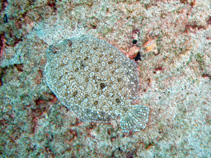Adicionar o seu Fotografias e vídeos
Pictures | Imagem do GoogleBothus mellissi
Picture by Wirtz, P.
Pictures | Imagem do GoogleBothus mellissi
Picture by Wirtz, P.
Classificação / Names Nomes comuns | Sinónimos | Catalog of Fishes(Género, Espécies) | ITIS | CoL | WoRMS | Cloffa
> Pleuronectiformes (Flatfishes) > Bothidae (Lefteye flounders)
Eponymy: John Charles Melliss (1835–1911) was an amateur naturalist. [...] (Ref. 128868), visit book page.
More on author: Norman.
Eponymy: John Charles Melliss (1835–1911) was an amateur naturalist. [...] (Ref. 128868), visit book page.
More on author: Norman.
Environment: milieu / climate zone / depth range / distribution range Ecologia
marinhas demersal; intervalo de profundidade 5 - 100 m (Ref. 5288). Tropical; 8°S - 17°S
Distribuição Países | Áreas FAO | Ecossistemas | Ocorrências | Point map | Introduções | Faunafri
Southeast Atlantic: known only from St. Helena and Ascension Islands.
Tamanho / Peso / Idade
Inhabits mud, sand, gravel and shell bottoms. Marketed fresh and dried salted.
Life cycle and mating behavior Maturidade | Reprodução | Desova | Ovos | Fecundidade | Larvas
Referência principal
Upload your references | Referências | Coordenador : Amaoka, Kunio | Colaboradores
Aldebert, Y., M. Desoutter and J.-C. Quéro, 1990. Bothidae. p. 1027-1036. In J.C. Quero, J.C. Hureau, C. Karrer, A. Post and L. Saldanha (eds.) Check-list of the fishes of the eastern tropical Atlantic (CLOFETA). JNICT, Lisbon; SEI, Paris; and UNESCO, Paris. Vol. 2. (Ref. 5979)
Categoria na Lista Vermelha da IUCN (Ref. 130435: Version 2024-2)
Preocupação menor (LC) ; Date assessed: 10 July 2012
CITES
Not Evaluated
Ameaça para o homem
Harmless
Utilização humana
Pescarias: pouco comercial
FAO - Publication: search | FishSource |
Mais informação
Trophic ecology
Itens alimentares
Composição da dieta
Consumo alimentar
Food rations
Predadores
Itens alimentares
Composição da dieta
Consumo alimentar
Food rations
Predadores
Ecology
Ecologia
Ecologia
Population dynamics
Parâmetros de crescimento
Max. ages / sizes
Length-weight rel.
Length-length rel.
Frequência de comprimento
Mass conversion
Recrutamento
Abundância
Parâmetros de crescimento
Max. ages / sizes
Length-weight rel.
Length-length rel.
Frequência de comprimento
Mass conversion
Recrutamento
Abundância
Life cycle
Reprodução
Maturidade
Maturity/Gills rel.
Fecundidade
Desova
Spawning aggregations
Ovos
Desenvolvimento dos ovos
Larvas
Dinâmica larvar
Reprodução
Maturidade
Maturity/Gills rel.
Fecundidade
Desova
Spawning aggregations
Ovos
Desenvolvimento dos ovos
Larvas
Dinâmica larvar
Anatomy
Área branquial
Brain
Otolith
Área branquial
Brain
Otolith
Physiology
Body composition
Nutrients
Consumo de oxigénio
Tipo de natação
Velocidade de natação
Visual pigments
Fish sound
Diseases & Parasites
Toxicity (LC50s)
Body composition
Nutrients
Consumo de oxigénio
Tipo de natação
Velocidade de natação
Visual pigments
Fish sound
Diseases & Parasites
Toxicity (LC50s)
Genetics
Genética
Heterozygosity
Hereditariedade
Genética
Heterozygosity
Hereditariedade
Human related
Aquaculture systems
Perfis para aquacultura
Estirpes
Ciguatera cases
Stamps, coins, misc.
Aquaculture systems
Perfis para aquacultura
Estirpes
Ciguatera cases
Stamps, coins, misc.
Ferramentas
E-book | Guia de campo | Ferramenta auxiliar de frequências de comprimento | Ferramenta sobre a história de vida | Mapa dos pontos | Classification Tree
| Catch-MSY |
Relatórios especiais
Descarregue XML
Fontes da internet
AFORO (otoliths) | Aquatic Commons | BHL | Cloffa | BOLDSystems | Websites from users | Consultar FishWatcher | CISTI | Catalog of Fishes: Género, Espécies | DiscoverLife | ECOTOX | FAO - Publication: search | Faunafri | Fishipedia | Fishtrace | GenBank: genoma, nucleotídeo | GloBI | Google Books | Google Scholar | Google | IGFA World Record | MitoFish | Otolith Atlas of Taiwan Fishes | PubMed | Reef Life Survey | Socotra Atlas | Árvore da vida | Wikipedia: ir para, procurar | World Records Freshwater Fishing | Zoobank | Registo zoológico
Estimates based on models
Phylogenetic diversity index (Ref. 82804): PD50 = 0.5000 [Uniqueness, from 0.5 = low to 2.0 = high].
Bayesian length-weight: a=0.01047 (0.00446 - 0.02457), b=3.04 (2.86 - 3.22), in cm total length, based on LWR estimates for this Genus-body shape (Ref. 93245).
Nível Trófico (Ref. 69278): 3.6 ±0.5 se; based on size and trophs of closest relatives
Resiliência (Ref. 120179): Médio, tempo mínimo de duplicação da população 1,4 - 4,4 anos (Preliminary K or Fecundity.).
Fishing Vulnerability (Ref. 59153): Low vulnerability (12 of 100).




